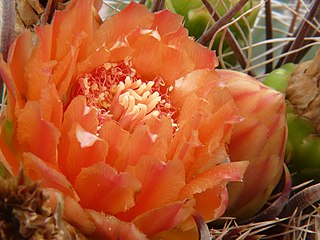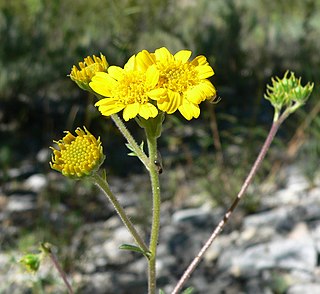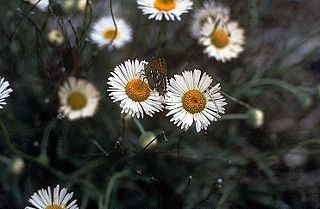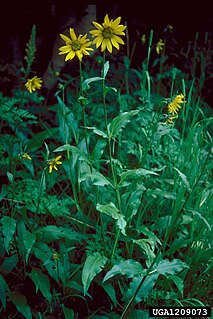
Ferocactus wislizeni, the fishhook barrel cactus, also called Arizona barrel cactus, candy barrel cactus, and Southwestern barrel cactus, is a species of flowering plant in the cactus family Cactaceae, native to northern Mexico and the southern United States. It is a ball-shaped cactus eventually growing to a cylindrical shape, with spiny ribs and red or yellow flowers in summer.
Senna wislizeni, commonly called Wislizenus' senna or shrubby senna. Formerly in the "wastebin taxon" Cassia sensu lato, it is now placed in the genus Senna or sometimes separated in Palmerocassia together with Senna unijuga.
Isocoma pluriflora, commonly called southern jimmyweed or southern goldenbush, is a North American species of flowering perennial herbs in the family Asteraceae. It grows in northern Mexico and in the southwestern and south-central United States.

Hymenothrix is a small genus of North American flowering plants in the daisy family known as thimbleheads. They are native to the southwestern United States and northern Mexico.

Carphochaete is a genus of North American flowering plants in the family Asteraceae. They are native to Mexico and the southwestern United States. They are known commonly as bristleheads.
Brickellia lemmonii, or Lemmon's brickellbush, is a North American species of flowering plants in the family Asteraceae. It is native to northeastern and north-central Mexico and the southwestern United States.
Brickellia baccharidea, the resinleaf brickellbush, is a North American species of shrubs in the family Asteraceae. It is native to the southwestern United States and northwestern Mexico.

Machaeranthera asteroides, the fall tansyaster, is a North American species of plants in the sunflower family. It is native to the southwestern United States and northern Mexico.

Erigeron modestus is a North American species of flowering plant in the family Asteraceae known by the common name plains fleabane. It native to northern Mexico and the southwestern and south-central parts of the United States.
Helianthus laciniatus is a North American species of sunflower known by the common name alkali sunflower. It is found in the southwestern United States and north-central Mexico. It is fairly common in the Chihuahuan Desert.
Solidago wrightii, commonly known as Wright's goldenrod, is a North American species of goldenrod in the family Asteraceae. It grows in northern Mexico and the southwestern United States.
Gutierrezia wrightii is a North American species of flowering plant in the family Asteraceae known by the common name Wright's snakeweed. It is native to the southwestern United States and northwestern Mexico.
Haploesthes greggii, common name false broomweed, is a North American species of flowering plants in the family Asteraceae. It grows in northeastern Mexico and in the south-central and southwestern United States.

Helianthella quinquenervis, the fivenerve helianthella, is a North American plant species in the family Asteraceae. It grows in the mountains of the western United States and northern Mexico. This include the Rockies, the Black Hills, the ranges of the Great Basin, and the northern Sierra Madre, from Montana, Oregon, and South Dakota south as far as western Chihuahua and Coahuila.
Hymenopappus flavescens, the collegeflower, is a North American species of flowering plant in the daisy family.

Hymenopappus mexicanus, the Mexican woollywhite, is a North American species of flowering plant in the daisy family. It grows in northern Mexico and the southwestern United States.

Hymenothrix wrightii is a North American species of flowering plant in the daisy family. It grows in northwestern Mexico and the southwestern United States.
Hymenothrix loomisii, the Loomis' thimblehead, is a North American species of flowering plant in the daisy family. It grows in the southwestern United States, and also in the Sierra Madre Occidental in western Chihuahua. There have been reports of populations in southern California but these are most likely introductions.
Hymenothrix palmeri is a North American species of flowering plant in the daisy family. It has been found only in the state of Chihuahua in northern Mexico.
Tetraneuris argentea, the perkysue, is a North American species of plants in the sunflower family. It grows in the southwestern United States, primarily in Arizona and New Mexico with additional populations in Utah, Colorado, and the Texas Panhandle.








